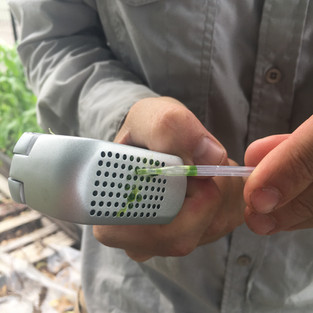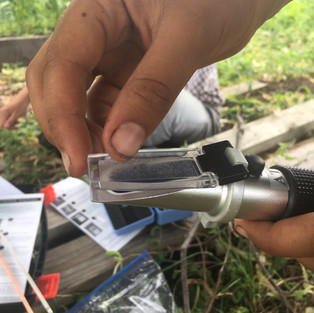This week in the Teaching Garden we donated over 200 pounds of produce to the Black Feminist Project including...
30 pounds of Swiss Chard,

58 pounds of Collard Greens,

a whopping 10.5 pounds of Basil,

14 pounds of Onions,

2 pounds of Jalapeños,

16 pounds of Eggplant,

30.5 pounds of Cucumbers,

18 pounds of Kale,

20 pounds of Cabbage, and 10 pounds of Cauliflower.

We are so glad to be able to provide lots of delicious, fresh, local, organically grown produce to such great organizations and the people they serve!
In other garden news, we have our first ripe tomato! In the next few weeks we should be swimming in them (you can see all the green ones in the background that should ripen soon).

Our rice has started to flower and seed! We are growing a few different varieties of rice this year.


We have also harvested our first few Bitter Melons.

This week we also tested our soil as part of a project we are working on in partnership with Carbon Sponge. Carbon sponge works with urban gardeners to explore the potential for urban soils to sequester carbon as a means to mitigate anthropogenic greenhouse gases. We are excited to learn more about carbon sequestration and how we can track our soil quality and our ability for our soil to sequester carbon simultaneously.

As a part of this project, we tested our soil's pH, temperature, moisture levels, and microbial biomass.
This device measured our soil's pH, which was around a healthy 7. The same device can be used to measure moisture content, and amount of light (both of which were also ideal).

We measured microbial biomass (which is a measure of the number of microbes present in our soil) by taking a small sample of soil, sifting it, and placing it in a vial with distilled water.

We then mixed our sample and let it sit for 10 minutes.
Then we placed it on a microBIOMETER, and used an app to read the number of microbes present in our soil.
We had excellent levels of microbes present in our soil!
Lastly, we measured the levels of sugar present in our Sorghum, which is a grain we are growing as a part of this project. To do this we picked off a few bits of its leaves and placed it in a garlic press. We used a garlic press to squeeze out some liquid from the leaf. We then placed this liquid in the refractometer to get our reading.
Lastly, enjoy this video to learn a little more about the lovely lavender!











Comentarios